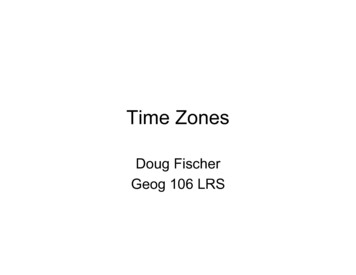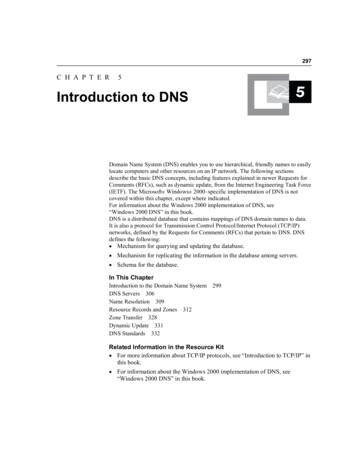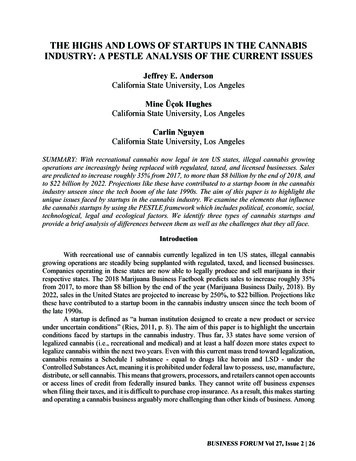
Transcription
Time ZonesDoug FischerGeog 106 LRS
Learning goals Students should be able to Explain time zones as a function oflongitude Calculate time differences betweendifferent locations Demonstrate corrections for daylightsavings time
Why we have time zones At the same instant that it’s noon for usit’s midnight for othersRays from the Sun(Looking “down” at the North Pole)
Time zones Are based on solar noon - when the subsolarpoint crosses your meridian Local solar time worked until railroads– Each town set its own time based on solar noon Consistent time zones are required for trains,phones, etc. We all set clocks to solar time of a “centralmeridian”– All towns set their clocks to solar noon of nearestcentral meridian
Time zones We generally use 24 time zones, allusing the same “minute hand” on theclock and just varying the “hour hand” This means there are 24 centralmeridians around the globe Width of a time zone?– (360 degrees of longitude around the Earthdivided by 24 time zones 15 degrees of longitude per time zone)
Locations of Time Zones Standard or “Nautical” time zones are15 degrees of longitude wide. The first central meridian is the PrimeMeridian, 0 E/W. The next central meridians are at 15 Eand 15 W.– A town at 6 W pretends to be on the PrimeMeridian, and sets its clocks to noon whenthe sun crosses 0 E/W.– A town at 9 W pretends to be at 15 W,and sets its clocks to noon when the suncrosses the time zone’s central meridian of15 W.
Nautical Time Zones150 W120 W90 W60 W30 W0 E/W30 E60 E90 E120 EIdealized Time Zone Map150 E180 E/W
Where is it earlier / later?Rays from the Sun Comparing two locations, the one to the East willexperience noon before the one to the West. On the East Coast of the US it is already 3pmwhen it’s noon in LA.
Mechanics Time zones progress one hour latereach 15 east one hour earlier each 15 west What happens to the date at midnight?– The date changes, right?– Same thing happens at the InternationalDate Line– When it’s 2:00 pm Monday at 175 E, it’s2:00 pm Sunday at 175 W
Sample problems When given a city location, you canorient yourself using a basic map likethis one.– LA is at 34 N x 118 W– NYC is at 41 N x 74 WLA xxNYC
Sample problems What is the central meridian of LA?– LA is at 34 N x 118 W– Closest number to 118 that is evenlydivisible by 15 is 120 - so 120 W What is the central meridian of NYC?– NYC is at 41 N x 74 W– Closest number to 74 that is evenlydivisible by 15 is 75 - so 75 W
Sample problems What time is it in LA when it is noon inGreenwich, England on the PrimeMeridian?– LA’s central meridian is 120 W– 120 W / 15 per time zone 8 time zones– The time is earlier to the west, right?– Noon minus eight hours 4 am in LA
Sample problems What time is it in Greenwich, UK when it isnoon in New York?– NYC’s central meridian is 75 W– 75 W / 15 per time zone 5 time zones– The time is later to the east, right?– Noon plus five hours 5 pm in Greenwich, UK
Sample Problems Another way to do this is to use anumber line marked in 15 increments. When it’s 9pm Sat in Greenwich, it’s10pm one time zone east, and 8pm onetime zone west. Note that the time zone centered on45 E has switched to the next day
Time Zones http://www.lib.utexas.edu/maps/world maps/time zone world 98.jpg Time zone boundaries on land are usuallydistorted to match political boundaries.
Daylight Savings TimeEngland DTEngland STLA on PSTLA on PDT We pretend to live 15 east of actual The central meridian for LA on PacificStandard Time (PST) is at 120 W, but weuse 105 W (Denver) on Pacific DaylightTime (PDT)
Daylight Savings TimeEngland DTEngland STLA on PSTLA on PDT Greenwich Mean Time (GMT) is thestandard by which all world clocks are set.* GMT never switches to daylight time. PST GMT – 8 hours PDT GMT – 7 hours*Actually there are slight differences betweenGMT and Universal Coordinated Time (UTC), thetrue international time standard. These nuances arebeyond the scope of this course.
Daylight Savings Time We use daylight savings time in the springand summer (March/April - October) We use standard time in late Fall andWinter, when days are shorter All countries that use daylight time do so intheir summers, though the dates that theyspring forward and fall back differ. Remember that summer in the southernhemisphere occurs during our winter andvice versa.
Conclusions Time zones are a function of longitude Nautical time zones are 15 wide Actual time zones on land aregerrymandered to match politicalboundaries Time differences can be calculated on anumber line
Locations of Time Zones Standard or "Nautical" time zones are 15 degrees of longitude wide. The first central meridian is the Prime Meridian, 0 E/W.










